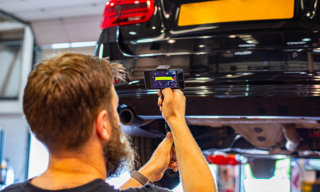The use of video within automotive sales and aftersales has expanded to become a core part of how a dealership operates. Within the workshop specifically, video is invaluable: allowing technicians to communicate directly with customers about the work that is required to their vehicle. This not only helps to build trust and understanding, but improves overall operational efficiency for the workshop.
Our research has found that video can boost conversion rates of proposed amber and red work by as much as 30%, thanks to customers having the right information to make quick decisions. Indeed, customers are often able to approve the work so quickly that the car is still on the ramp and the workshop team can get started straight away.
Over the years, we’ve watched countless workshop videos, so we know what it takes to make them stand out and resonate with customers the most. The CitNOW Academy plays a vital role in driving learning and skills development, with the aim to help you maximise the potential of personalised videos. To keep up-to-date with the latest video trends and customer preferences, they are consistently reviewing and refining their tips and techniques. In this blog we’re sharing their latest learnings: eight top tips for creating engaging, empowering workshop videos that get the job done.
The key elements of a successful workshop video
It’s important to remember that videos can be beneficial every time a vehicle comes in for a check – whether work is required or not. If every area of a car comes back green following a check, then a video highlighting this will help build reassurance and trust with the customer, and prevent a possible perception that videos are only ever sent out when there are problems that need to be resolved.

To help maximise the impact of all your workshop videos, follow these eight tips:
- Complete your eVHC first: when developing a video, you want to have all the relevant information to hand before you start. So make sure you complete the vehicle health check and consider the results before you start recording. Ideally, you should work out the order you’ll address each area of the car, and how you’ll explain any problems that have arisen. However, it should be noted that through the use of Multipart, workshop technicians can conduct the eVHC and record the video simultaneously
- Get equipped: using the right hardware and equipment to aid your video can make a major difference to professionalism. This includes camera-related accessories like laser pointers and stabilisation sticks, to workshop items like tyre depth gauges and professional gloves
- Focus on the first impression: it’s vital to engage customer attention right from the start, with a clear introduction of yourself, and a tone that is both positive and professional. Visually, we recommend a starting shot of the car on the ground with its registration plate visible, from which you can explain to the customer the areas you’re about to cover
- Make explanations engaging: it’s vital that videos are free of technical jargon, so that any customer is easily able to understand what’s going on. Take your time in highlighting concerns with a clear explanation that isn’t rushed, using measurements to add further weight to it
- Cover the DOC: a good way to approach any issues with the vehicle is a three-step process we call DOC: Discovery (identifying the problem), Origin (explaining the cause) and Correction (how it can be fixed, and what the consequences are if it is not fixed
- Ensure video quality: take into account the surroundings when you film, such as lighting quality, and make sure you move slowly around or underneath the vehicle so that the picture remains clear
- Capture every detail: striking the right balance between covering every detail and making sure a video isn’t too long can be tricky. This can be solved by using Multipart, which is a stop and start function that stitches all the key points together smoothly
- Follow-up and evaluate: make sure you check back to see whether videos have been watched, and whether ratings and comments have been given, and follow up with customers. The information you can pick up can help inform your video production in the future, in terms of what to do and what not to do
In summary
By generating long-term loyalty in customers, and improving the efficiency and throughput, video has a key part to play in supporting successful workshops. The tips above can help you exploit the potential of workshop video to its fullest, so that you can use CitNOW Workshop more effectively, improve video engagement and success rates, and ultimately boost your bottom line.
Support better video quality and consistency in your workshop with our scoring sheet that can help you improve your assets. And if your team has created a video you’re particularly proud of, then why not submit it for our 2023 Digital Spotlight Awards?





